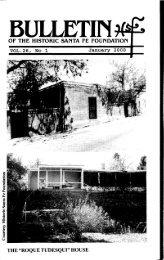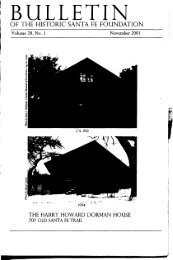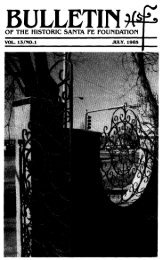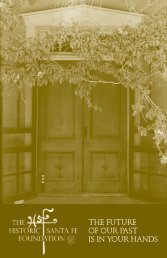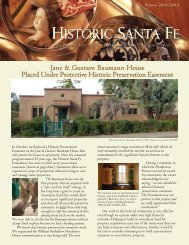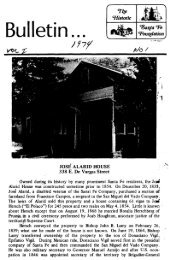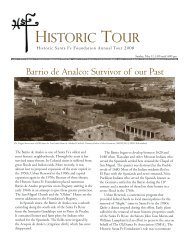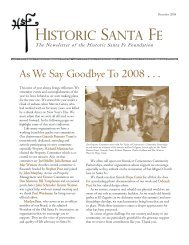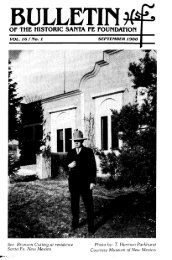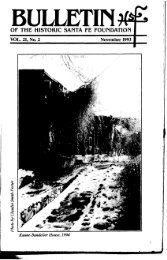Witter Bynner House - Historic Santa Fe Foundation
Witter Bynner House - Historic Santa Fe Foundation
Witter Bynner House - Historic Santa Fe Foundation
You also want an ePaper? Increase the reach of your titles
YUMPU automatically turns print PDFs into web optimized ePapers that Google loves.
<strong>Bynner</strong>'s passion for collecting<br />
led him to acquire great<br />
numbers of objects which he<br />
used to adorn his home. In<br />
China he collected paintings, of<br />
which 139 examples on silk or<br />
paper were exhibited in a special<br />
showing in <strong>Santa</strong> <strong>Fe</strong> in<br />
1928.10 He also amassed over<br />
300 Chinese carved girdle<br />
clasps, or belt buckles made<br />
mostly of jade but also of other<br />
materials, such as chalcedony,<br />
jasper, ivory, amber, brass,<br />
wood, and Peking glass, each<br />
on its own teakwood stand.l1<br />
In 1953 he gave portions of his<br />
collection of oriental art to the<br />
Roswell Museum.12<br />
Shortly after his arrival in<br />
<strong>Santa</strong> <strong>Fe</strong>, <strong>Bynner</strong> was given a<br />
silver Indian bracelet by<br />
Willard Nash. Intrigued, he<br />
began collecting Indian-made<br />
jewelry with his usual fervor.<br />
In the 1920s he formed the<br />
Spanish- Indian Trading Company<br />
with the painter Andrew<br />
Dasburg, Mabel Dodge Luhan's<br />
son John Evans, and others. At<br />
their store across from La<br />
Fonda they successfully sold<br />
jewelry and other handmade<br />
items weeded from their own<br />
collections or purchased on frequent<br />
buying trips. For 25 years<br />
extensive loaned displays from<br />
<strong>Bynner</strong>'s personal collection<br />
formed the nucleus of exhibits<br />
of American Indian jewelry at<br />
the Museum of New Mexico.<br />
In 1954 he deeded an impressive<br />
collection of 222 Navajo<br />
and Pueblo pieces to the School<br />
7<br />
of American Research and in<br />
1956added 130examples of his<br />
"better pieces."13<br />
After settling in <strong>Santa</strong> <strong>Fe</strong>,<br />
<strong>Bynner</strong> continued to publish<br />
poetry, plays, satire, translations,<br />
and less frequently,<br />
prose. His national recognition<br />
as a poet peaked in the 1920s<br />
coinciding with the popularity<br />
of lyric poetry. Thereaft~r,<br />
poetic fashion turned towa.rd<br />
less accessible artists like Ezra<br />
Pound and T.S. Eliot.<br />
Nevertheless, he continued<br />
until 1960 to regularly publish<br />
volumes of poetry, which we.re<br />
nationally reviewed.<br />
of satire contInued<br />
The vein<br />
with his<br />
1935 Guest Book, a collection of<br />
poems each pottraying an<br />
unnamed specific friend or<br />
acquaintance as a type, such as<br />
the Debutante, Communist,<br />
Ghost, Gourmand, Poetess, or<br />
Spouse. Among his subjects<br />
were Thornton Wilder, Amy<br />
Lowell, Carl Van Vechten, Max<br />
Eastman, Robinson Jeffers, and<br />
of course Mabel Dodge Luhan.<br />
In 1944 he published his most<br />
popular work, his version of<br />
Laotzu entitled The Way of Life<br />
According to Laotzu, which had<br />
been refused by Knopf, his<br />
usual publisher, for fear that it<br />
would not be successful.<br />
The <strong>Bynner</strong> <strong>House</strong> grew<br />
from a three-room adobe<br />
dwelling first rented from Paul<br />
Burlin in June of 1922.l4 In 1920<br />
Budin's wife, Natalie Curtis,<br />
had purchased from Adela<br />
Rivera de Alarid, a house con-



